The Washington Post reported on April 15 that 17 Iranian officials visited a Russian air defense system factory in Yekaterinburg, Russia, in March 2023.[i] The factory produces S-400 air defense missiles and mobile launchers, among other military equipment.[ii] The US Treasury Department’s Office of Foreign Assets Control sanctioned the company that owns the factory—NPP Start—in June 2022 for supporting Russia’s invasion of Ukraine.[iii] Unspecified intelligence officials told the Washington Post that Russia is “advancing” an agreement with Iran to supply Iran with Su-35 fighter jets.[iv] Iran has long sought, but not yet received, Su-35s in return for supplying Russia with drones. US and Middle Eastern intelligence officials assessed that delayed Iranian payments to Russia may be hindering Iran’s acquisition of the fighter jets.[v] Russia previously provided Iran with at least two Yak-130 combat trainer aircraft in September 2023, which Iranian media framed as a “necessary prelude” for the acquisition of Su-35s.[vi]
Senior Iranian officials emphasized that Iran would strike Israel again “faster and stronger” if Israel retaliates to Iran’s April 13 missile and drone attack. Iranian Deputy Foreign Affairs Minister Ali Bagheri Kani stated that Iran would respond against Israeli within a “few seconds” of an Israeli attack.[vii] Iranian President Ebrahim Raisi emphasized in separate phone calls to several foreign leaders, including his Qatari and Russian counterparts, that Iran would respond “more fiercely, widely and painfully” if Israel retaliates against Iran.[viii] The spokesperson of Iran’s Parliamentary National Security and Foreign Policy Committee claimed that Iran is “ready to use weapons that [it] has not used before” during an interview with Lebanese Hezbollah-controlled media on April 16.[ix]
Key Takeaways:
- Iran: The Washington Post reported that 17 Iranian officials visited a Russian air defense system factory in Yekaterinburg, Russia, in March 2023.
- Senior Iranian officials emphasized that Iran would strike Israel again “faster and stronger” if Israel retaliates to Iran’s April 13 missile and drone attack.
- Northern Gaza Strip: Palestinian sources reported that Israeli forces are operating around Beit Hanoun.
- Political Negotiations: US Secretary of State Antony Blinken said that Hamas rejected the most recent ceasefire agreement because it thought the April 13 Iranian attack on Israel would lead to a regional conflict.
- West Bank: Israeli forces clashed with Palestinian fighters in at least three locations across the West Bank.
- Southern Lebanon and Golan Heights: Lebanese Hezbollah conducted at least nine attacks from southern Lebanon into northern Israel, including a one-way drone attack targeting an Iron Dome battery.
- Iraq: Iraqi Prime Minister Mohammad Shia al Sudani continued his official visit to Washington, DC.
- Yemen: Houthi President Mahdi al Mashaat congratulated Iranian President Ebrahim Raisi for the April 13 Iranian attack targeting Israel during a phone call.
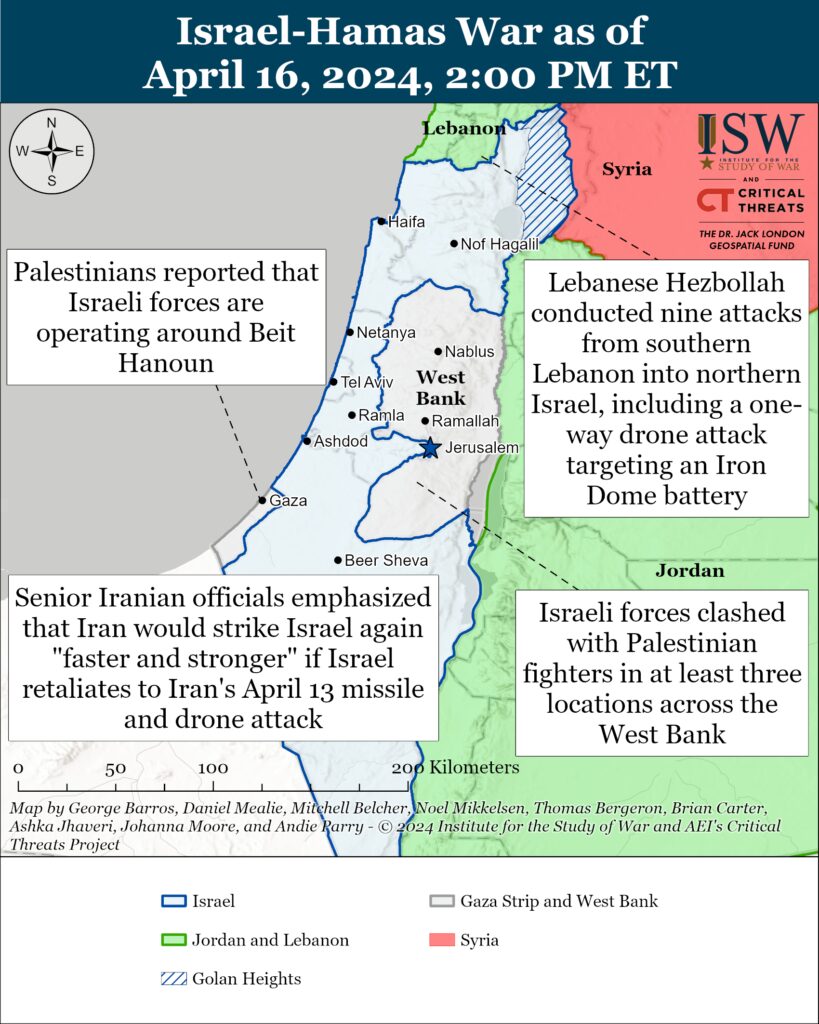
Gaza Strip
Axis of Resistance objectives:
Erode the will of the Israeli political establishment and public to sustain clearing operations in the Gaza Strip
Reestablish Hamas as the governing authority in the Gaza StripPalestinian sources reported on April 16 that Israeli forces are operating around Beit Hanoun. Several local Palestinian sources reported that Israeli armored vehicles entered Beit Hanoun and areas east of Jabalia. The sources reported that Israeli forces ordered civilians in Beit Hanoun and areas east of Jabalia to leave.[x] One report noted that Israeli forces are conducting an unspecified military operation in the area.[xi] The Democratic Front for the Liberation of Palestine (DFLP), which is a leftist Palestinian militia aligned with Hamas in the war, mortared Israeli forces in eastern Jabalia on April 15.[xii]
The Israel Defense Forces (IDF) have not issued official evacuation orders for the area as of the time of writing. CTP-ISW assessed on March 25 that a small number of Palestinian fighters have likely infiltrated Beit Hanoun.[xiii] The ability of Palestinian militias to continue to operate in the northern Gaza Strip is consistent with the infiltration of fighters into the area and Hamas efforts to reassert its governing authority following the drawdown of Israeli forces.
The IDF Nahal Brigade (162nd Division) continued operations near Nuseirat in the central Gaza Strip on April 16.[xiv] Israeli forces engaged Palestinian fighters and destroyed military infrastructure. The al Aqsa Martyrs’ Brigades fired rockets targeting an Israeli command and control node in southwestern Gaza City on April 15.[xv] The Israeli defense minister said in February 2024 that the IDF has not defeated all four Hamas battalions in the central Gaza Strip, and that it intends to dismantle the two remaining battalions.[xvi] CTP-ISW previously observed that Palestinian militias, including Hamas, have likely used a rear area in the central Gaza Strip to conduct attacks since mid-December that have targeted Israeli forces in the northern Gaza Strip.[xvii] Palestinian militias have also likely been able to infiltrate from the central strip into previously cleared areas of southern Gaza City. The IDF has conducted multiple raids in southern Gaza City since it decreased its force presence in the northern Gaza Strip in early 2024.[xviii]
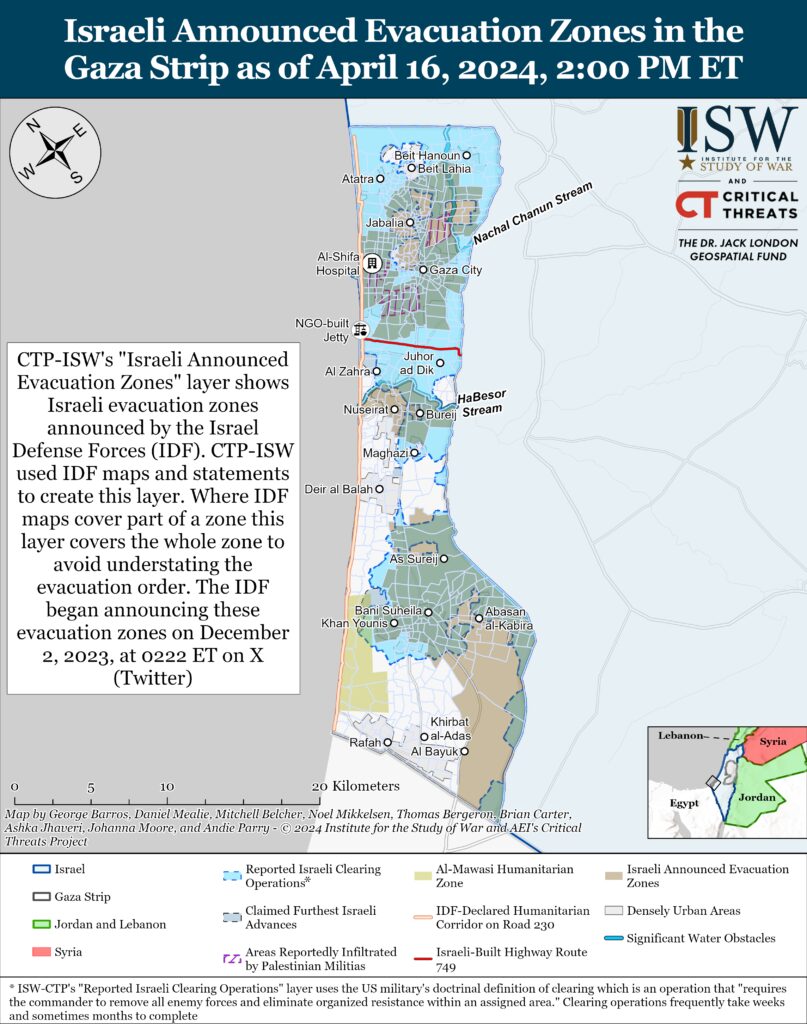

The Coordinator of Government Activities in the Territories (COGAT)—a department within the Israeli Defense Ministry—said that 126 aid trucks entered the northern Gaza Strip on April 16.[xix] Israeli media reported that the delivery was part of IDF-COGAT efforts to increase aid deliveries into the Gaza Strip and especially into the northern Gaza Strip.[xx] The initiatives include opening two bakeries and working on the Bani Suheil water pipeline, according to Israeli media.
US Secretary of State Antony Blinken said that Hamas rejected the most recent ceasefire agreement because it thought the April 13 Iranian attack on Israel would lead to a regional conflict.[xxi] Two attendees of a meeting between Blinken and American Jewish leaders told Axios about the substance of Blinken’s comments at the meeting. Hamas rejected the US-proposed ceasefire and hostage-for-prisoner exchange deal on April 13 hours before the Iranian drone and missile attack on Israel.[xxii] Hamas has since demanded new concessions from Israel in its counteroffer, according to one Israeli official.[xxiii] The official said that Hamas sought to release fewer Israeli hostages in addition to asking for a higher ratio of hostage-for-prisoners and for Israel to release more Palestinian prisoners held under a life sentence.
Palestinian fighters fired two rockets from the northern Gaza Strip into southern Israel on April 16.[xxiv] An Israeli military correspondent reported that both rockets struck open areas, causing no casualties or damage.[xxv]
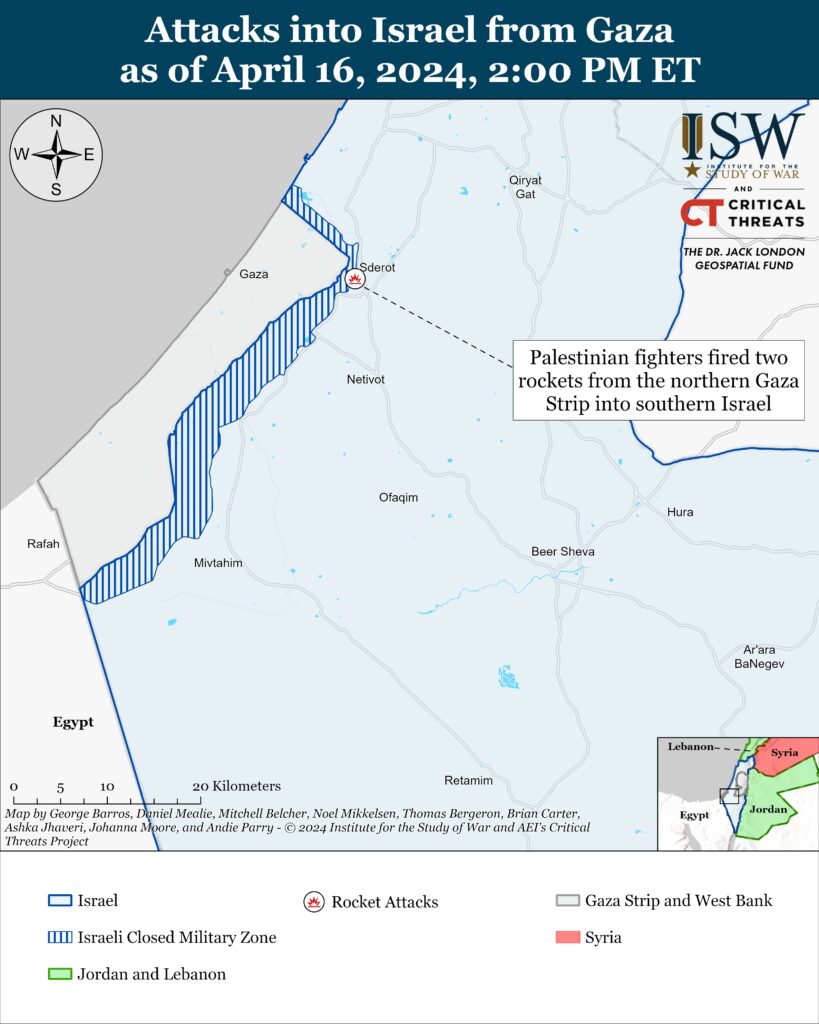
Recorded reports of attacks; CTP-ISW cannot independently verify impact.
West Bank
Axis of Resistance objectives:
Establish the West Bank as a viable front against IsraelIsraeli forces have clashed with Palestinian fighters in at least three locations across the West Bank since CTP-ISW’s last data cut off on April 15. The IDF reported on April 16 that Israeli forces detained 23 wanted Palestinians during overnight operations in the West Bank.[xxvi] Palestinian Mujahideen Movement fighters detonated an IED targeting Israeli forces in al Askar refugee camp. The militia separately targeted Israeli forces advancing into Nablus with unspecified munitions.[xxvii] The al Aqsa Martyrs’ Brigades shot at Israeli forces operating in Jenin.[xxviii]

This map is not an exhaustive depiction of clashes and demonstrations in the West Bank.
Southern Lebanon and Golan Heights
Axis of Resistance objectives:
Deter Israel from conducting a ground operation into Lebanon
Prepare for an expanded and protracted conflict with Israel in the near term
Expel the United States from SyriaLebanese Hezbollah launched one-way attack drones targeting an Iron Dome battery near Beit Hilal.[xxix] Hezbollah has only claimed four attacks targeting Israeli Iron Dome batteries during the Israel-Hamas war.[xxx] LH previously claimed a drone attack targeting an Israeli Iron Dome battery on April 13 hours before the Iranian attack against Israel.[xxxi] The IDF confirmed that two one-way attack drones entered Israeli airspace and exploded near Beit Hilal.[xxxii] Israeli Army Radio reported that the drone attack injured three people and caused significant damage to unspecified ”property.”[xxxiii]
Hezbollah conducted at least nine attacks from southern Lebanon into northern Israel on April 16, including the one-way drone attack targeting the Iron Dome battery.[xxxiv]
The IDF killed two Hezbollah commanders in southern Lebanon on April 16.[xxxv] The IDF Air Force killed the commander of the Radwan Unit’s rocket and missile unit in Hezbollah’s Western Sector, Mohammed Hossein Metzafa Shouri.[xxxvi] The IDF added that Shouri oversaw the planning and execution of ”many” rocket and missile attacks from southern Lebanon into Israeli territory. The IDF also killed a commander from Hezbollah’s ”Coastal Sector,” Esmail Yousef Baz.[xxxvii] Baz held a rank equivalent to a brigadier general and served as a ”senior” Hezbollah military official. Baz was responsible for directing rocket and anti-tank guided missile attacks into northern Israel.[xxxviii] Hezbollah acknowledged Baz’s death.[xxxix]
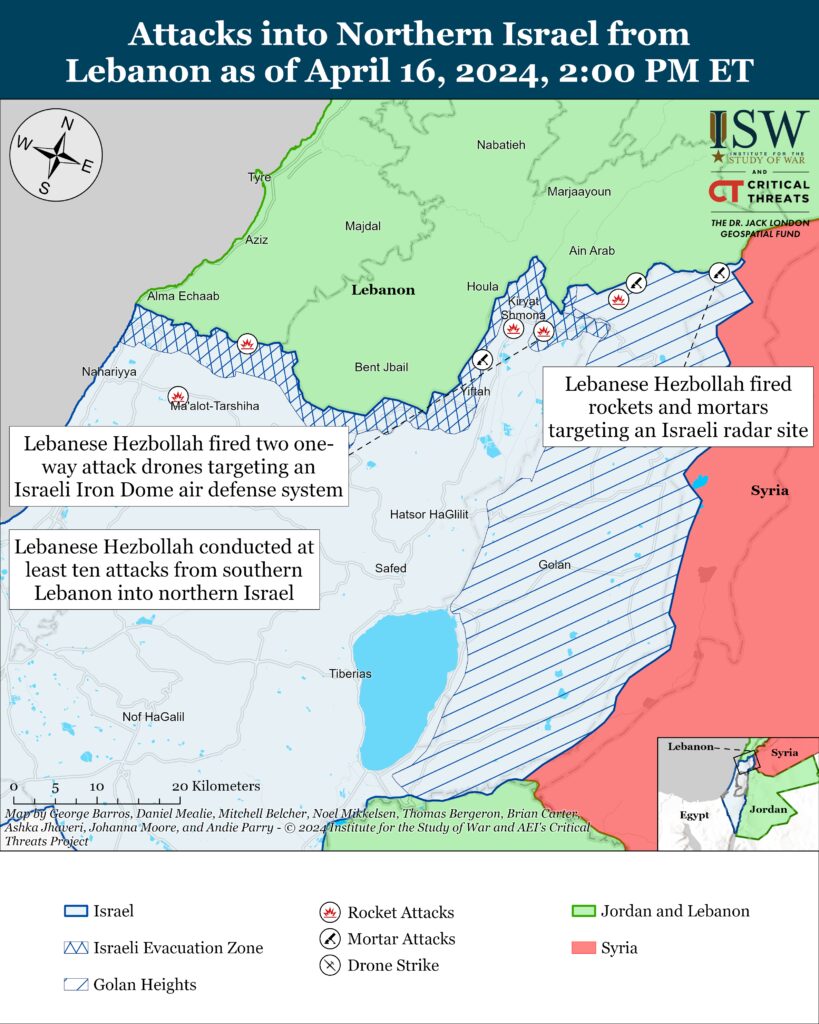
Recorded reports of attacks; CTP-ISW cannot independently verify impact.
Iran and Axis of Resistance
Iranian Foreign Affairs Minister Hossein Amir Abdollahian spoke with several of his foreign minister counterparts and representatives from various international organizations in separate phone calls on April 15 and 16.[xl] Abdollahian spoke separately with the foreign ministers of China, Oman, Indonesia, and Malaysia, among others. Abdollahian held additional separate phone calls with the Shanghai Cooperation Organization Secretary General and the Organization of Islamic States Secretary General on April 16.[xli] Abdollahian claimed in his separate calls with the Indonesian foreign minister and Omani foreign minister that Israel is responsible for tension and instability in the region.[xlii] The foreign ministers of Malaysia, Austria, and the United Nations Secretary General Antonio Guterres urged restraint from all parties involved.[xliii]
An anti-regime outlet posted a video of the Iranian military transporting drones, tanks, and other assorted military equipment in Tehran on April 16.[xliv] This is likely in preparation for the annual Artesh Day parade, which is held on April 18.
Iraqi Prime Minister Mohammad Shia al Sudani continued his official visit to Washington, DC on April 16. US Defense Secretary Lloyd Austin expressed support for transitioning to an “enduring bilateral security relationship” with Iraq during a meeting with Sudani on April 15.[xlv] Sudani has emphasized during 2024 that he seeks to end the US-led international coalition’s presence in Iraq and transition to a “comprehensive” bilateral relationship with the United States.[xlvi] Sudani also claimed that Iraqi Security Forces are “at a high level of readiness” and are prepared to ensure security and stability in Iraq.[xlvii] Iraqi security forces still face significant deficiencies in fire support, intelligence, and logistics that would impede their ability to eliminate ISIS and other domestic threats alone.[xlviii] Austin also stated that Iraqi Defense Minister Thabet Mohammad al Abbasi requested “the pricing and availability” of US counter-drone systems on April 13.[xlix] Militias in the Iraqi Popular Mobilization Forces—a security service that exists outside of the Defense Ministry—have repeatedly launched drones targeting US troops in Iraq. Sudani separately met with a delegation from the US defense company General Dynamics on April 16 to discuss developing Iraqi tanks and other armor.[l] General Dynamics Land Systems builds US M1 Abrams tank, and Iraq operates Abrams tanks.
Sudani also held separate meetings with US Deputy Secretary of the Treasury Wally Adeyemo and US Secretary of Homeland Security Alejandro Mayorkas on April 16.[li] Sudani and Adeyemo discussed “rehabilitating” Iraqi banks to meet international standards.[lii] The United States has worked with Iraq in recent years to “improve the compliance procedures of Iraqi banks” to align Iraqi banks with international standards and “prevent terrorists, criminals, and corrupt and other illicit actors from accessing both the Iraqi and international financial systems.”[liii] The US Treasury Department identified the Iraqi al Huda Bank as a “conduit for terrorist financing” and imposed sanctions on the bank’s owner in late January 2024.[liv]
Houthi President Mahdi al Mashaat congratulated Iranian President Ebrahim Raisi for the April 13 Iranian attack targeting Israel during a phone call on April 16.[lv] Mashaat reaffirmed Yemen’s support for the Iranian attack. The Houthis also took part in the Iranian attack on April 13 by firing missiles and drones from Yemen targeting Israel.[lvi] Mashaat expressed an interest in ”expanding and strengthening relations” with Iran in ”various fields“.[lvii] Raisi praised Houthi attacks against Israel and international shipping in the Red Sea. Raisi said that these Houthi attacks demonstrate Yemen’s ”resistance” and support for Palestinians.[lviii]
Houthi-controlled media claimed on April 16 that the United States and the United Kingdom conducted two airstrikes targeting unspecified sites in Bajil District, Hudaydah Governorate, western Yemen.[lix] The United States and United Kingdom have not confirmed any airstrikes in Yemen at this time of writing.
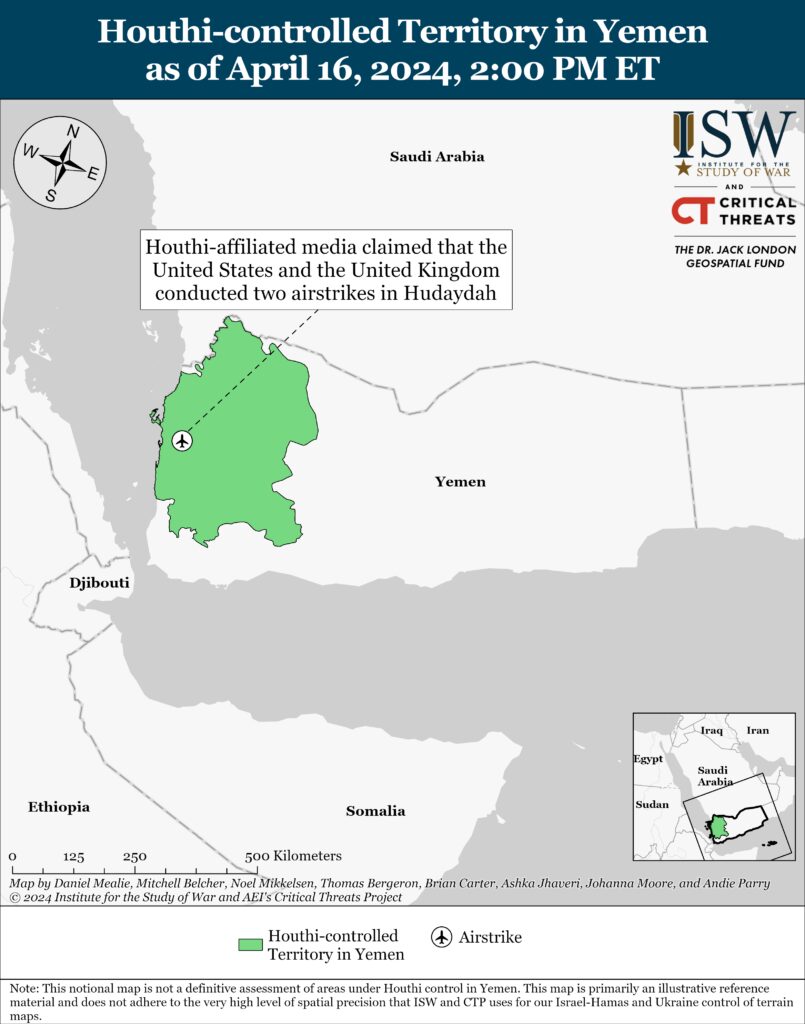
 Eurasia Press & News
Eurasia Press & News


